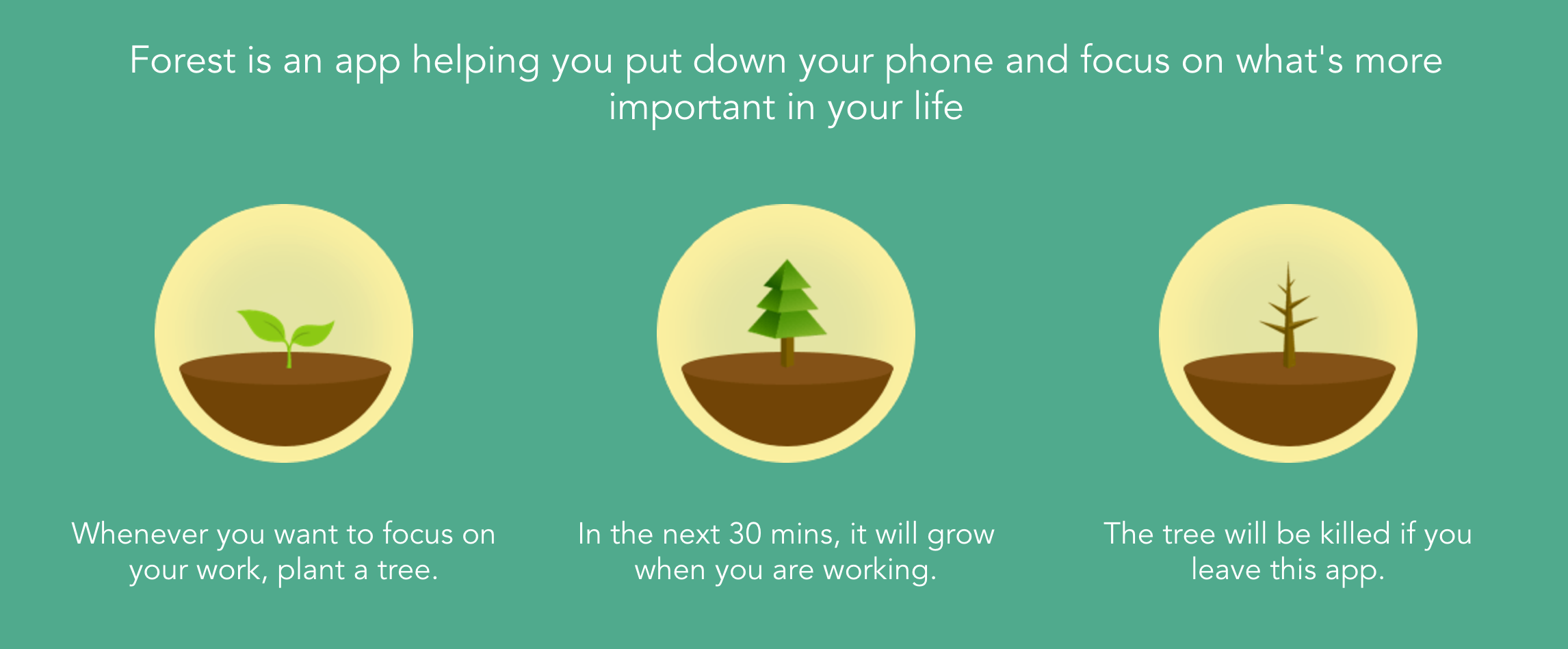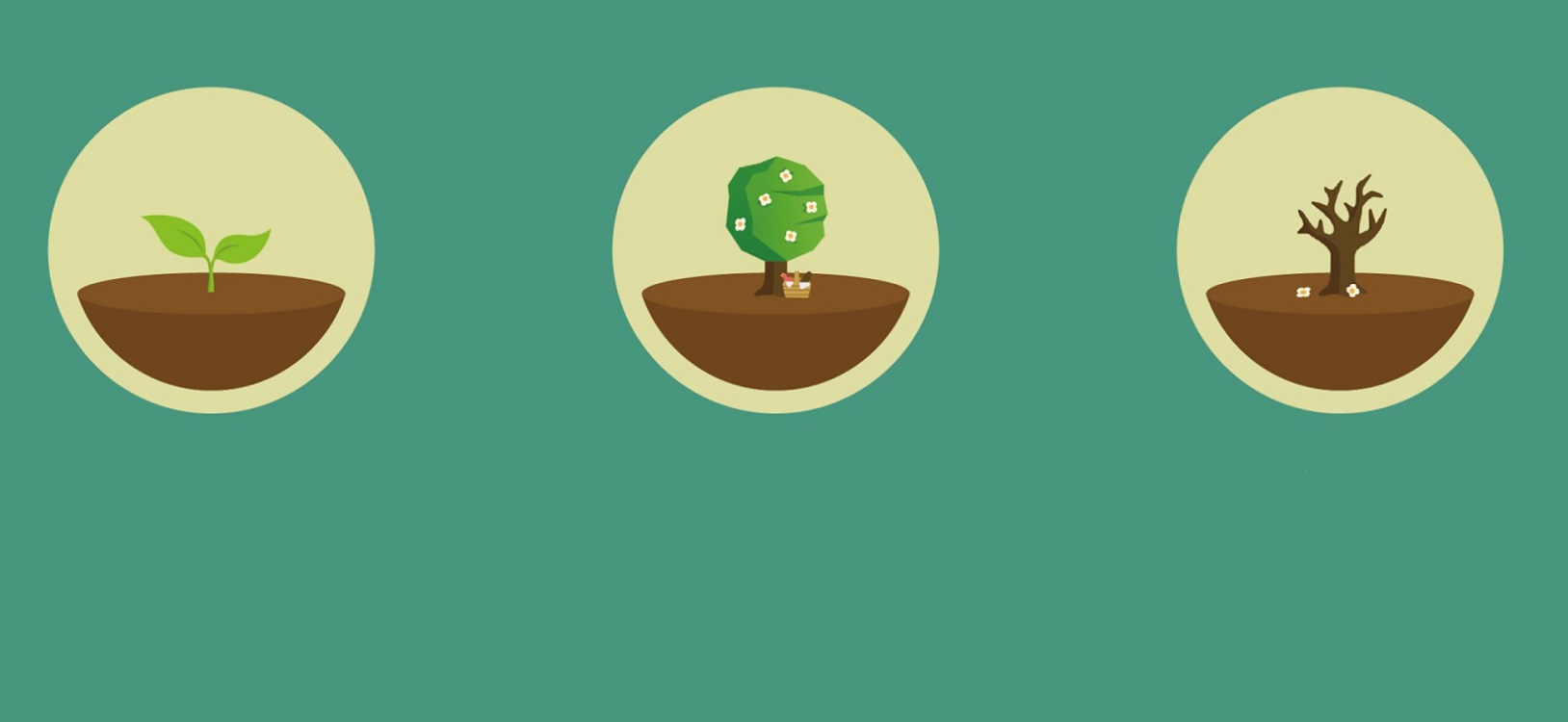Focusing can be surprisingly uncomfortable. If you’ve got an overactive imagination (read: crippling ADD), it can be damn near unbearable, especially when you have to focus on something you’d rather not learn; like pre-Calculus or the American tax code, or whatever repetitive drudgery you’re currently being paid to perform. A person like that—this writer, for instance—would greatly benefit from a formal system to help them get through life’s monotonous but mandatory moments. A system like the Forest productivity app, which visually represents your periods of sustained effort with virtual trees.

Life’s A Forest, Dig It
Here’s how the experience grows, I mean, “goes”: Every day you sit down with the productivity app and pick a unit of time (5 minutes to 2 hours); and then you get to work. As you proceed, your seed grows into a sapling right in front of you (on your smartphone). Eventually it grows into a bush (<25 minutes) or a tree (>25 minutes). The app delivers helpful reminders like, “Don’t look at your phone!” and “[Seriously] Don’t look at me!” as you reach full genesis.
If you try to use your phone while you’re supposed to be working, your tree will die, and then sit in your forest as a reminder to the others. If you stick to your guns, and grow trees week in and week out, you can transfer some of your focus currency into sponsoring actual trees in Zambia, India, and elsewhere, through the charity Trees for the Future. This gives your daily to-do list a noticeable dose of purpose.

The other option would be to spend your currency unlocking new tree designs, if you hate growing trees in the third world.
To be fair, the designs in the Forest productivity app are some of its best features. They bring to mind other particularly addictive self-improvement apps—like Headspace the meditation app. There’s a clear and consistent design, giving you the illusion that you’re playing an actual video game, like a real-life Farmville. The visual reward of the attractive design, the growth animations, and the easy-to-manipulate virtual forest all help you link boring work to stimulating, enjoyable cues. This makes developing and sticking to habits more satisfying and dare I say, fun? Oh, I dare. Growing my forest is at least as fun as Pokemon: Go, and I have some incentive to play it for longer than 3 days.
But will I be growing trees in a few months? Hard to say—these self-improvement and productivity apps tend to come and go. In fact, one productivity methodology thinks that an app can never go far enough, and that a good-old-fashioned egg timer, a pencil, and a pad of paper will beat a virtual forest any day.
You Say Tomato, I Say Pomodoro
Pomodoros are a time management technique developed in the 1980s by Francesco Cirillo. Since its invention in Cirillo’s college dorm room, where he first used a tomato-shaped egg timer (“Pomodoro” means, “Tomato” in Italian), the method has grown into a successful book and app, with dozens of copycats—Forest included.
The Pomodoro technique uses 25 minute blocks of time, with 5 minute breaks, and it emphasizes an even more sensual experience; the timer clicks away reassuringly in the background like a metronome. When you have a thought, or complete a Pomodoro, you note it on a physical pad of paper, giving you the satisfaction that white-collar employees savor around the world—that sweet, sweet checklist mark.
The Best of Both Worlds
After trying both Pomodoros and the Forest app, I think they work best in concert. Forest is still command central, storing all of the day’s data and visualizing it, but the tried and true paper and egg timer add a number of physical and sensual cues that help you stay glued to the page. If you’re not willing to pay $1.99 for a lifetime of Forest use, there are also plenty of free Pomodoro apps that will track your progress.
My ancestors would have used cigarettes and long lines of Benzedrine to stay in their chairs; now we’ve got trees and tomatoes.

One of the things I like about both of these methods is that they emphasize self-analysis. They give you a way to quantify the time and effort you put into each task; the daily and weekly outputs, and the number of times you get distracted. They also require you to choose to work several times a day, recommitting to your main objectives.
The emphasis on breaks will help you transition. It’s tempting to want to skip them, but like with any activity, rest is an important part of long-term growth. These breaks are also great opportunities for you to move and stretch (gotta avoid that sittin’ cancer) and to get chores done that might distract you otherwise.
Or you could be like me and just let your brain recover from the trauma you just put it through. Focusing can make you feel uneasy, but eventually it delivers one of the deepest satisfactions a human being can feel: “I did my work today.”

